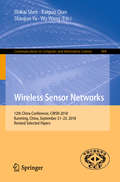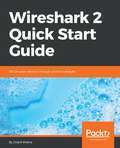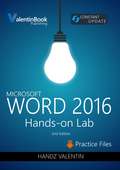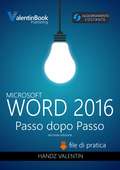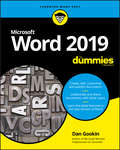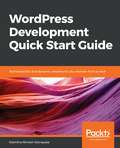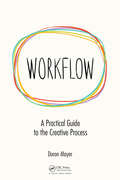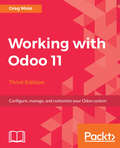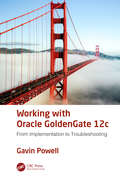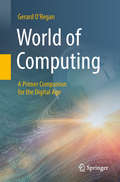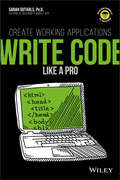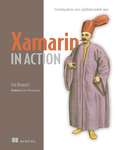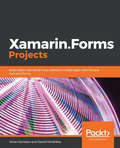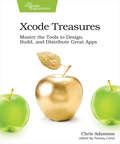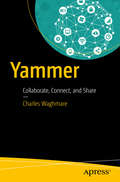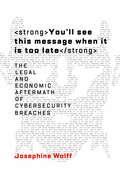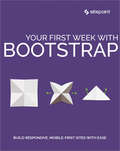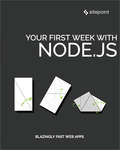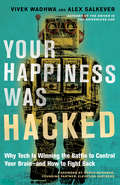- Table View
- List View
Wireless Networking Principles: From Terrestrial to Underwater Acoustic
by Shengming JiangThis book systematically summarizes the fundamentals and various technologies in both terrestrial radio wireless networks and underwater acoustic networks (UWANs). It addresses the basic issues frequently investigated in terrestrial radio wireless networks and the key technologies suitable for the newly developing research area of UWANs. Starting with a review of our current understanding of wireless networks, it then introduces the principles of the main technologies, including error control, medium access control (MAC) protocols, routing protocols, end-to-end transmission control and mobility issues as well as network security for terrestrial radio wireless networks, and offers detailed surveys of these technologies for UWANs.Providing readers with the basic knowledge of terrestrial radio wireless networking technologies and raising readers’ awareness of the developing topic of UWANs in ocean , it is a valuable resource for researchers and practitioners in terrestrial radio wireless networks and UWANs.
Wireless Personal Communications: Simulation And Complexity (Signals And Communication Technology)
by Mohsen A. M. El-BendaryThis book introduces wireless personal communications from the point of view of wireless communication system researchers. Existing sources on wireless communications put more emphasis on simulation and fundamental principles of how to build a study model. In this volume, the aim is to pass on to readers as much knowledge as is essential for completing model building of wireless communications, focusing on wireless personal area networks (WPANs). This book is the first of its kind that gives step-by-step details on how to build the WPANs simulation model. It is most helpful for readers to get a clear picture of the whole wireless simulation model by being presented with many study models. The book is also the first treatise on wireless communication that gives a comprehensive introduction to data-length complexity and the computational complexity of the processed data and the error control schemes. This volume is useful for all academic and technical staff in the fields of telecommunications and wireless communications, as it presents many scenarios for enhancing techniques for weak error control performance and other scenarios for complexity reduction of the wireless data and image transmission. Many examples are given to help readers to understand the material covered in the book. Additional resources such as the MATLAB codes for some of the examples also are presented.
Wireless Sensor Networks: 12th China Conference, Cwsn 2018 Kunming, China, September 21-23, 2018, Revised Selected Papers (Communications in Computer and Information Science #984)
by Shikai Shen Kaiguo Qian Shaojun Yu Wu WangThis book constitutes the refereed proceedings of the 12th China Conference on Wireless Sensor Networks, CWSN 2018, held in Kunming, China, in September 2018. <P><P> The 16 revised full papers were carefully reviewed and selected from 177 submissions. The papers are organized in topical sections on algorithm for wireless sensor network; positioning and location; neural network; energy efficiency and harvesting; privacy and security; image processing.
Wireshark 2 Quick Start Guide: Secure your network through protocol analysis
by Charit MishraProtect your network as you move from the basics of the Wireshark scenarios to detecting and resolving network anomalies.Key FeaturesLearn protocol analysis, optimization and troubleshooting using Wireshark, an open source toolLearn the usage of filtering and statistical tools to ease your troubleshooting jobQuickly perform root-cause analysis over your network in an event of network failure or a security breachBook DescriptionWireshark is an open source protocol analyser, commonly used among the network and security professionals. Currently being developed and maintained by volunteer contributions of networking experts from all over the globe. Wireshark is mainly used to analyze network traffic, analyse network issues, analyse protocol behaviour, etc. - it lets you see what's going on in your network at a granular level. This book takes you from the basics of the Wireshark environment to detecting and resolving network anomalies.This book will start from the basics of setting up your Wireshark environment and will walk you through the fundamentals of networking and packet analysis. As you make your way through the chapters, you will discover different ways to analyse network traffic through creation and usage of filters and statistical features. You will look at network security packet analysis, command-line utilities, and other advanced tools that will come in handy when working with day-to-day network operations.By the end of this book, you have enough skill with Wireshark 2 to overcome real-world network challenges.What you will learnLearn how TCP/IP works Install Wireshark and understand its GUICreation and Usage of Filters to ease analysis processUnderstand the usual and unusual behaviour of ProtocolsTroubleshoot network anomalies quickly with help of WiresharkUse Wireshark as a diagnostic tool for network security analysis to identify source of malwareDecrypting wireless trafficResolve latencies and bottleneck issues in the networkWho this book is forIf you are a security professional or a network enthusiast who is interested in understanding the internal working of networks and packets, then this book is for you. No prior knowledge of Wireshark is needed.
Word 2016 Hands-On Lab
by Handz ValentinThe new way to learn Word 2016 immediately, and now the ebook is constantly updated with new topics. Learn at your own pace with real "step by step" exercises to guarantee your learning. Do not forget to download the practice files for free. With Word 2016 Step by Step you will learn to: - Know the Word 2016 interface in a simple way - Apply font and paragraph formats to your documents - Configure your documents and decorate it for a better presentation - Insert images, graphics and other content. - Add table of contents and print
Word 2016 Passo Dopo Passo
by Handz ValentinIl libro "Word 2016: Passo dopo passo" è una guida all'utilizzo delle funzioni del programma di elaborazione testi più conosciuto al mondo. Redatto in maniera molto semplice, è rivolto sia a utenti principianti, che a utenti più esperti. Inoltre, contiene dei file di pratica che servono per esercitarsi e che si possono scaricare gratuitamente.
Word 2019 For Dummies
by Dan GookinThe bestselling beginner’s guide to Microsoft Word Whether you've used older versions of this popular program or have never processed a single word, this hands-on guide gets you going with the latest version of Microsoft Word. In no time, you'll begin editing, formatting, proofing, and dressing up your Word documents like a pro. In this leading book about the world’s number one word processing application, Dan Gookin talks about using Microsoft Word in friendly, easy-to-follow terms. Focusing on the needs of the beginning Word user, it provides everything you need to know about Word—without any painful jargon. Covers the new and improved features found in the latest version of Word Create your own templates Explains why you can’t always trust the spell checker Offers little-known keyboard shortcuts If you’re new to Word and want to spend more time on your actual work rather than figuring out how to make it work for you, this new edition of Word X For Dummies has you covered.
WordPress Development Quick Start Guide: Build beautiful and dynamic websites for your domain from scratch
by Rakhitha Nimesh RatnayakeLearn core WordPress concepts and components to create modern WordPress-based solutionsKey FeaturesLearn the foundations of WordPress development and its hook-based architectureChoose the right components for any development taskBuild flexible solutions that works with existing plugins and themesBook DescriptionWordPress is the most used CMS in the world and is the ideal way to share your knowledge with a large audience or build a profitable business. Getting started with WordPress development has often been a challenge for novice developers, and this book will help you find your way.This book explains the components used in WordPress development, when and where to use them, and why you should be using each component in specific scenarios. You begin by learning the basic development setup and coding standards of WordPress. Then you move into the most important aspects of the theme and plugin development process. Here you will also learn how themes and plugins fit into the website while learning about a range of techniques for extending themes and plugins.With the basics covered, we explore many of the APIs provided by WordPress and how we can leverage them to build rapid solutions. Next, we move on to look at the techniques for capturing, processing, and displaying user data when integrating third-party components into the site design.Finally, you will learn how to test and deploy your work with secure and maintainable code, while providing the best performance for end users.What you will learnExplore the role of themes, plugins, and built-in features in developmentAdapt to built-in modules and built-in database structuresWrite code for WordPress's hook-based architectureBuild, customize, and integrate WordPress pluginsExtend themes with custom design templatesCapture and process data with built-in features and custom formsImprove usability with AJAX and third-party componentsManage non-functional aspects, such as security, performance, and migrationWho this book is forThis book is for web developers and site owners who want to build custom websites with WordPress. Basic knowledge of PHP, JavaScript, HTML and CSS is required to get most out of this book.
Work From Home: 50 Ways to Make Money Online Analyzed
by Michael EzeanakaMichael Ezeanaka, provides a step-by-step analysis of 50 business models that have the potential to earn you passive income. A quick overview of each business is presented and their simplicity, passivity, scalability and level of competition in the marketplace are explored.
Workflow: A Practical Guide to the Creative Process
by Doron MeirA pro isn’t just a person who can do it well. It’s a person who can do it well every time, on demand and on deadline; which is why the key to being a professional creative is having a great creative process. Whether it’s writing a book, animating a shot, designing a game level or composing a soundtrack—ultimately, we’re all facing similar challenges. Since we share challenges, we can also share solutions. This book is a practical guide, featuring a universal creative process that can streamline any serious creative work, on any scale. Key Features Universal approach: applies to any process that starts with an idea and ends with a refined product. Profound and light: combines conceptual ideas with practical tips and fun anecdotes. Caricatures and samples: helps visually clarify ideas and processes. Variety of creative fields: draws on examples from writing, animation, game design, 3D modeling, music, sculpting and more Printable summaries: provides visual outlines that can be used as cheat-sheets.
Working with Odoo 11: Configure, manage, and customize your Odoo system, 3rd Edition
by Greg MossTransform and modernize your businesses and upgrade your enterprise management skills with Odoo 11, the most comprehensive management softwareKey FeaturesUse project management along with analytics for better reportingBuild an Odoo module and integrate it with other platforms with this practical guideExplore new design and mobile updates from the Odoo enterpriseBook DescriptionOdoo is an all-in-one management software that offers an array of business applications, forming a complete suite of enterprise management applications. Odoo 11 comes with advances on usability, speed, and design.Working with Odoo 11 starts with how to set up Odoo, both online and on your own server. You’ll then configure the basic company settings required to quickly get your first Odoo system up and running. Later, you’ll explore customer relationship management in Odoo and its importance in a modern business environment. You'll then dive into purchasing applications with Odoo, learn some of the primary functionalities of ERP systems for manufacturing operations, and use analytic accounting to provide better reporting. After that, you'll learn how to work with Odoo for mobile, and finally, you will walk through the recent Odoo 11 features with respect to the community and enterprise edition, giving you a complete understanding of what Odoo can do for your business.What you will learnConfigure a functioning customer relationship management systemSet up a purchasing and receiving systemImplement manufacturing operations and processes using real-world examplesDiscover the capabilities of Odoo's financial accounting and reporting featuresIntegrate powerful human resource applicationsUtilize Odoo's project management application to organize tasksCustomize Odoo without writing a line of codeWho this book is forThis book is for beginners, and will help you learn advanced-level features with Odoo such as creating your own custom modules. You do not need any prior knowledge of Odoo.
Working with Oracle GoldenGate 12c: From Implementation to Troubleshooting
by Gavin PowellThis book teaches the basics of Oracle GoldenGate, which is a product that is used to simplify the process of Oracle Database Replication. GoldenGate can be used for reporting, failover, high availability, live reporting, data warehousing, and BigData ETL process, as well as connecting to multiple other data sources outside of Oracle Database such as SQL Server, MySQL, Teradata, PostgreSQL, and many others. The purpose of GoldenGate and its popularity is its ability to make the highly complex architecture of database replication into a much more simplistic task. This book teaches the reader how to use Oracle GoldenGate, from installation to troubleshooting.
World of Computing: A Primer Companion For The Digital Age
by Gerard O'ReganThis engaging work provides a concise introduction to the exciting world of computing, encompassing the theory, technology, history, and societal impact of computer software and computing devices. Spanning topics from global conflict to home gaming, international business, and human communication, this text reviews the key concepts unpinning the technology which has shaped the modern world.Topics and features: introduces the foundations of computing, the fundamentals of algorithms, and the essential concepts from mathematics and logic used in computer science; presents a concise history of computing, discussing the historical figures who made important contributions, and the machines which formed major milestones; examines the fields of human−computer interaction, and software engineering; provides accessible introductions to the core aspects of programming languages, operating systems, and databases; describes the Internet revolution, the invention of the smartphone, and the rise of social media, as well as the Internet of Things and cryptocurrencies; explores legal and ethical aspects of computing, including issues of hacking and cybercrime, and the nature of online privacy, free speech and censorship; discusses such innovations as distributed systems, service-oriented architecture, software as a service, cloud computing, and embedded systems; includes key learning topics and review questions in every chapter, and a helpful glossary.Offering an enjoyable overview of the fascinating and broad-ranging field of computing, this easy-to-understand primer introduces the general reader to the ideas on which the digital world was built, and the historical developments that helped to form the modern age.
World of Warcraft Chronicle Volume 3
by Blizzard EntertainmentBlizzard Entertainment and Dark Horse Books are proud to present the third installment of their bestselling World of Warcraft Chronicle series!Like its predecessors, Volume III features beautiful full-color artwork by Peter Lee, Emily Chen, Stanton Feng, and other fan-favorite artists, as well as intricately detailed maps and spot art by Joseph Lacroix. Bolster your knowledge of Warcraftlore with this striking third volume!
Wreck-It Ralph 2 Little Golden Book (Little Golden Book)
by Nancy ParentA Little Golden Book version of the exciting new Disney film Ralph Breaks the Internet: Wreck-It Ralph 2--coming to theaters in November 2018!Walt Disney Animation Studios welcomes Wreck-It Ralph back to the big screen for a smashing sequel! This time, Wreck-It Ralph leaves the arcade behind, venturing into the expansive universe of the internet--which may or may not survive Ralph's not-so-light touch. This Little Golden Book is based on the upcoming feature film Ralph Breaks the Internet: Wreck-It Ralph 2, releasing in November 2018. It is perfect for boys and girls ages 2 to 5, as well as Disney Little Golden Book collectors of all ages!
Write Code Like a Pro: Create Working Applications
by Sarah GuthalsCODERS ARE ROCK STARS Coders are the people who are building the future. You can stake your own claim on the future by learning pro coding techniques. Take a look inside to figure out how and why coders think a bit differently, the basics of building a working application with a professional coding language, and how to test your app to make sure it works. Get a jump on your future as a rock-star coder today! See the big picture – get a grip on how pro coders start and finish a project Know the code – get your hands on a pro coding language and put it to work Make things happen – create a working application you can share with friends
Xamarin in Action: Creating native cross-platform mobile apps
by Jim BennettSummaryXamarin in Action teaches you to build cross-platform mobile apps using Xamarin and C#. You'll explore all the layers of a Xamarin app, from design to deployment. By the end, you'll be able to build a quality, production-ready Xamarin app on iOS and Android from scratch with a high level of code reuse.Purchase of the print book includes a free eBook in PDF, Kindle, and ePub formats from Manning Publications.About the TechnologyRewriting the same app for iOS and Android is tedious, error-prone, and expensive. Microsoft's Xamarin drastically reduces dev time by reusing most application code—typically 70% or more. The core of your iOS and Android app is shared; you write platform-specific code only for the UI layer. And because Xamarin uses C#, your apps benefit from everything this modern language and the .NET ecosystem have to offer.About the BookXamarin in Action teaches you to build cross-platform mobile apps using Xamarin and C#. You'll explore all the layers of a Xamarin app, from design to deployment. Xamarin expert Jim Bennett teaches you design practices that maximize code reuse and isolate device-specific code, making it a snap to incorporate the unique features of each OS.What's InsideUnderstanding MVVM to maximize code reuse and testabilityCreating cross-platform model and UI logic layersBuilding device-specific UIsUnit and automated UI testingPreparing apps for publication with user tracking and crash analyticsAbout the ReaderReaders should have some experience with C#. Mobile development experience is helpful, but not assumed.About the AuthorJim Bennett is a Xamarin MYP, Microsoft MVP, and Senior Cloud Developer Advocate at Microsoft, specializing in Xamarin mobile apps. He's a frequent speaker at events all around the world, including Xamarin user groups and Xamarin and Microsoft conferences. He regularly blogs about Xamarin development at https://jimbobbennett.io.Table of ContentsPART 1 - GETTING STARTED WITH XAMARIN Introducing native cross-platform applications with Xamarin Hello MVVM—creating a simple cross-platform app using MVVM MVVM—the model-view–view model design pattern Hello again, MVVM—understanding and enhancing our simple MVVM appWhat are we (a)waiting for? An introduction to multithreading for Xamarin apps PART 2 - BUILDING APPSDesigning MVVM cross-platform apps Building cross-platform models Building cross-platform view models Building simple Android views Building more advanced Android views Building simple iOS views Building more advanced iOS views PART 3 - FROM WORKING CODE TO THE STORERunning mobile apps on physical devices Testing mobile apps using Xamarin UITest Using App Center to build, test, and monitor apps Deploying apps to beta testers and the stores
Xamarin.Forms Projects: Build Seven Real-world Cross-platform Mobile Apps With C# And Xamarin. Forms
by Johan Karlsson Daniel HindrikesThe book is for mobile application developers who want to start building native mobile apps and use the knowledge that they already have. Working knowledge of C#, .NET and Visual Studio is required.
Xcode Treasures: Master the Tools to Design, Build, and Distribute Great Apps
by Chris AdamsonLearn the critical tips and techniques to make using Xcode for the iPhone, iPad, or Mac easier, and even fun. Explore the features and functionality of Xcode you may not have heard of. Go under the hood to discover how projects really work, so when they stop working, you'll know how to fix them. Explore the common problems developers face when using Xcode, and find out how to get the most out of your IDE. Dig into Xcode, and you'll discover it's richer and more powerful than you might have thought. Get a huge productivity boost by working with Xcode instead of against it. Instead of hacky code fixes and manual processes, once you know the the why and how of Xcode's process, you'll discover that doing things Xcode's way makes your app development more elegant and less aggravating. Explore the major features of Xcode: project management, building UIs with storyboards, code editing, compiling apps, fixing bugs and performance problems, unit- and UI testing, and source code management. Go beyond the basics and explore tasks that professionals deal with when they're working on big projects. Create storyboards that many developers can work on at once, even as projects grow to hundreds or thousands of files. Find the tools that make the code editor pleasant to work with, even in long coding sessions. Discover the right way to find and fix bugs when you have lots of code that's not always playing nicely together.Dig into specific and little-discussed features that help developers on Apple's other platforms: macOS, watchOS, and tvOS. When you're ready to distribute your app, learn how Apple's code-signing system really works. Find out when to let Xcode handle it automatically, and how to do it manually when needed. Discover how much easier and more fun iOS development is when you know the secrets of the tools. What You Need:This book requires Xcode 9 and a Mac running macOS High Sierra (10.13.2) or later. Additionally, an iOS device is recommended for on-device testing but not required.
Yammer: Collaborate, Connect, and Share
by Charles WaghmareBuild a successful Yammer implementation, make your workplace social and collaborative, create a culture of sharing, form expert communities and generate innovative solutions. Besides, this book will help to enhance your collaboration your suppliers, partners, and clients. The author starts by giving an introduction to social collaborations and successful implementations of Yammer. Along the way, he explains the art of community management in Yammer using his hands-on experience of building communities. He then explains methods to keep a Yammer network engaged followed by a description of running a campaign on Yammer. The second part of Yammer begins with ways you can engage entire organizations, including executives, on Yammer along with methods to measure the success of a Yammer network. You’ll see how to get to grips with integrating Yammer with an existing platform and how to collaborate with customers, suppliers, and partners using Yammer. Finally, you’ll learn various innovative techniques of communication using Yammer and explore the author’s vision of the next-generation Yammer platform After reading this book you will understand how to make successful Yammer implementations, engage communities on Yammer, and accomplish business goals using Yammer.What You Will LearnMaster the art of community managementMake your organization digital by implementing and integrating Yammer Break silos and create a collaborative workforceKeep Yammer groups live and full of participationImprove collaboration between suppliers, partners, and clientsMeasure the success of your Yammer networkIncrease employee engagement on Yammer Who This Book Is ForYammer adoption managers, community managers, customer success managers, and Yammer group admins.
You'll See This Message When It Is Too Late: The Legal and Economic Aftermath of Cybersecurity Breaches (Information Policy)
by Josephine WolffWhat we can learn from the aftermath of cybersecurity breaches and how we can do a better job protecting online data. Cybersecurity incidents make the news with startling regularity. Each breach—the theft of 145.5 million Americans' information from Equifax, for example, or the Russian government's theft of National Security Agency documents, or the Sony Pictures data dump—makes headlines, inspires panic, instigates lawsuits, and is then forgotten. The cycle of alarm and amnesia continues with the next attack, and the one after that. In this book, cybersecurity expert Josephine Wolff argues that we shouldn't forget about these incidents, we should investigate their trajectory, from technology flaws to reparations for harm done to their impact on future security measures. We can learn valuable lessons in the aftermath of cybersecurity breaches. Wolff describes a series of significant cybersecurity incidents between 2005 and 2015, mapping the entire life cycle of each breach in order to identify opportunities for defensive intervention. She outlines three types of motives underlying these attacks—financial gain, espionage, and public humiliation of the victims—that have remained consistent through a decade of cyberattacks, offers examples of each, and analyzes the emergence of different attack patterns. The enormous TJX breach in 2006, for instance, set the pattern for a series of payment card fraud incidents that led to identity fraud and extortion; the Chinese army conducted cyberespionage campaigns directed at U.S.-based companies from 2006 to 2014, sparking debate about the distinction between economic and political espionage; and the 2014 breach of the Ashley Madison website was aimed at reputations rather than bank accounts.
YouTube Marketing: Comprehensive Beginner's Guide to Learn Youtube Marketing from A to Z
by Jack SanchezYoutube Marketing: Comprehensive beginners guide to learn Youtube marketing from A to Z
Your First Week With Bootstrap
by Syed Fazle Rahman Maria Antonietta Perna Ahmed Bouchefra Ilya Bodrov-Krukowski Craig Watson Rhiana Heath Ivaylo GerchevBootstrap stands as one of the most popular, open-source, front-end frameworks on the Web. Since its official release in 2011, it has undergone several changes, and it's now one of the most stable and responsive frameworks available. It's loved by web developers of all levels, as it gives them the capability to build a functional, attractive website design within minutes. A novice developer with just some basic knowledge of HTML and little CSS can easily get started with Bootstrap. In this book we'll take you through Bootstrap basics, introduce you to its major features, and get you building your first Bootstrap sites. It contains: Why I Love Bootstrap, and Why You Should Too by Syed Fazle RahmanUnderstanding Bootstrap: How it Works, and What's New by Syed Fazle RahmanSuper Smart New Features to Win You Over by Maria Antonietta PernaUnderstanding Bootstrap Modals by Syed Fazle Rahman A Deep Dive into the Bootstrap Form Component by Ilya Bodrov-KrukowskiThe Card Component: a Complete Introduction by Ahmed BouchefraHow to Build a Responsive Type Scale with Bootstrap by Craig WatsonA Beginner's Guide to the Latest Bootstrap Utility Classes by Ilya Bodrov-Krukowski3 Tips for Speeding Up Your Bootstrap Website by Maria Antonietta PernaCustomizing Bootstrap jQuery Plugins by Maria Antonietta Perna8 Tips for Improving Bootstrap Accessibility by Rhiana HeathFront-end Frameworks: Custom vs Ready-to-use Solutions by Ivaylo Gerchev This book is for all frontend developers who want to build responsive, mobile-first websites. You'll need to be familiar with HTML and CSS and have a reasonable level of understanding of JavaScript in order to follow the discussion.
Your First Week With Node.js
by Mark Brown Michael Wanyoike Camilo Reyes Manjunath M Florian Rappl James Hibbard Jay RajWhile there have been quite a few attempts to get JavaScript working as a server-side language, Node.js (frequently just called Node) has been the first environment that's gained any traction. It's now used by companies such as Netflix, Uber and Paypal to power their web apps. Node allows for blazingly fast performance; thanks to its event loop model, common tasks like network connection and database I/O can be executed very quickly indeed. From a beginner's point of view, one of Node's obvious advantages is that it uses JavaScript, a ubiquitous language that many developers are comfortable with. If you can write JavaScript for the client-side, writing server-side applications with Node should not be too much of a stretch for you. In this book, we'll offer a beginner's introduction to Node and its related technologies, and get you under way writing your first Node applications. It contains: What Is Node and When Should I Use It? by James Hibbard A Beginner Splurge in Node.js by Camilo Reyes and Michiel MuldersA Beginner's Guide to npm- the Node Package Manager by Michael Wanyoike and Peter DierxForms, File Uploads and Security with Node.js and Express by Mark BrownMEAN Stack: Build an App with Angular 2+ and the Angular CLI by Manjunath MDebugging JavaScript with the Node Debugger by Camilo ReyesUsing MySQL with Node.js and the mysql JavaScript Client by Jay RajHow to Use SSL/TLS with Node.js by Florian Rappl and Almir Bijedic This book is for anyone who wants to start learning server-side development with Node.js. Familiarity with JavaScript is assumed, but we don't assume any previous back-end development experience.
Your Happiness Was Hacked: Why Tech Is Winning the Battle to Control Your Brain--and How to Fight Back
by Vivek Wadhwa Alex Salkever"Technology is a great servant but a terrible master. This is the most important book ever written about one of the most significant aspects of our lives—the consequences of our addiction to online technology and how we can liberate ourselves and our children from it."—Dean Ornish, M.D. Founder & President, Preventive Medicine Research Institute, Clinical Professor of Medicine, UCSF, Author, The SpectrumTechnology: your master, or your friend? Do you feel ruled by your smartphone and enslaved by your e-mail or social-network activities? Digital technology is making us miserable, say bestselling authors and former tech executives Vivek Wadhwa and Alex Salkever. We've become a tribe of tech addicts—and it's not entirely our fault. Taking advantage of vulnerabilities in human brain function, tech companies entice us to overdose on technology interaction. This damages our lives, work, families, and friendships. Swipe-driven dating apps train us to evaluate people like products, diminishing our relationships. At work, we e-mail on average 77 times a day, ruining our concentration. At home, light from our screens is contributing to epidemic sleep deprivation. But we can reclaim our lives without dismissing technology. The authors explain how to avoid getting hooked on tech and how to define and control the roles that tech is playing and could play in our lives. And they provide a guide to technological and personal tools for regaining control. This readable book turns personal observation into a handy action guide to adapting to our new reality of omnipresent technology.


